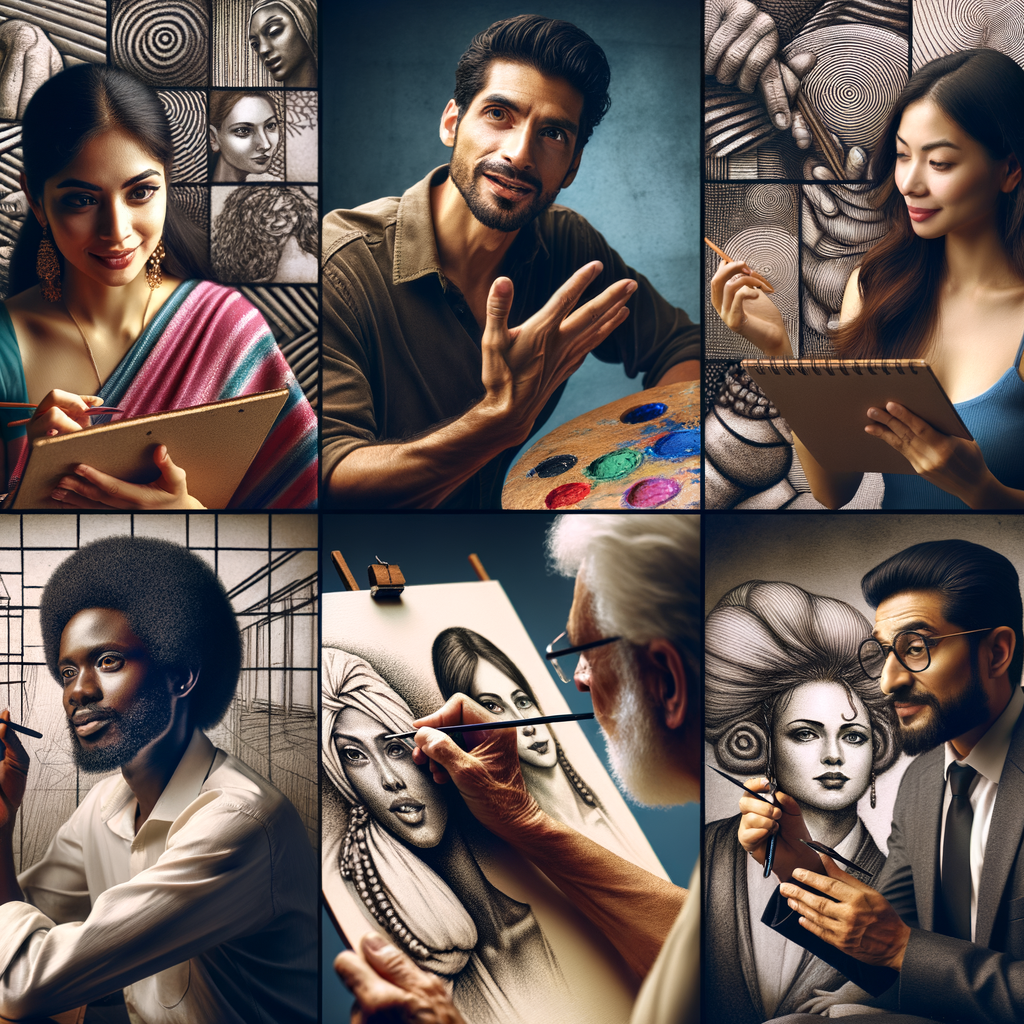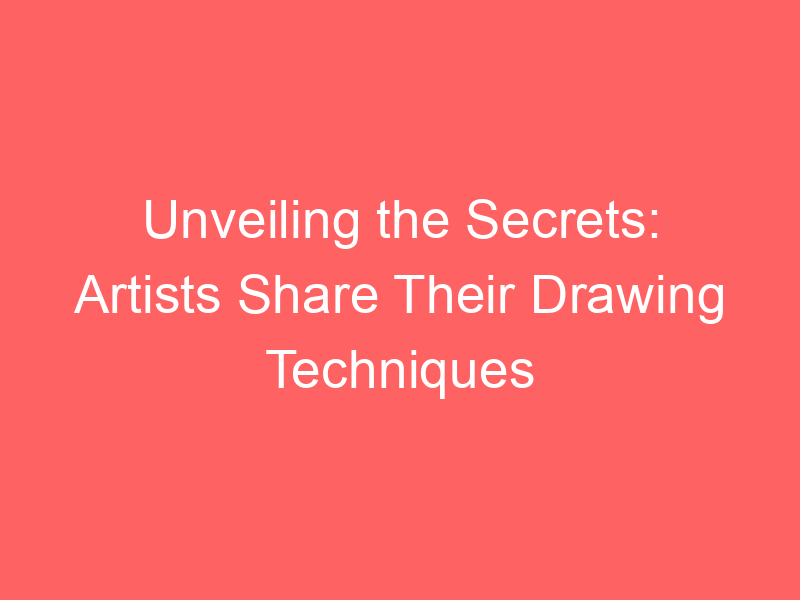
Introduction: Artists and Their Drawing Techniques
Art is a universal language that transcends boundaries and cultures. It is a medium through which artists express their thoughts, emotions, and perspectives. One of the most fundamental aspects of art, particularly in the realm of drawing, is the technique. Drawing techniques are the methods and styles that artists use to bring their visions to life on paper or canvas.
- Understanding the Importance of Drawing Techniques in Art
- How Drawing Techniques Can Define an Artist’s Style
Drawing techniques are not just about creating an image; they are about conveying a message. The way an artist uses lines, shapes, shading, and textures can communicate a range of emotions and ideas. For instance, an artist might use bold, heavy lines to express anger or frustration, while soft, delicate lines could suggest tranquility or sadness. The technique is a tool that artists use to connect with their audience on a deeper level.
Every artist has a unique style, and this style is often defined by their drawing techniques. Some artists prefer to use realistic techniques, creating drawings that closely resemble their subjects. Others might lean towards abstract techniques, using shapes and colors to represent their subjects in a more symbolic way. The choice of technique can say a lot about an artist’s personality and worldview. For example, an artist who uses a lot of bright, vibrant colors might be seen as optimistic and energetic, while an artist who uses more muted, darker colors could be perceived as introspective and thoughtful.
Understanding the importance of drawing techniques and how they can define an artist’s style is crucial for anyone interested in art. Whether you’re an aspiring artist looking to develop your own style, or an art enthusiast seeking to deepen your appreciation of the art world, a knowledge of drawing techniques can provide valuable insights.
Artist Interviews: Revealed Art Techniques
Let’s delve into the world of professional artists and uncover the secrets behind their unique drawing techniques.
Interview with Artist A: Professional Drawing Techniques
We had the privilege to sit down with Artist A, a renowned professional in the art world, to discuss their journey and drawing techniques. Here’s what we learned:
- Artist A’s Background and Artistic Journey
- Exploring Artist A’s Unique Drawing Techniques
- How Artist A’s Techniques Have Evolved Over Time
Artist A’s journey into the world of art began at a young age. Fascinated by the power of lines and colors, they spent countless hours sketching and painting. Their passion led them to the prestigious Royal College of Art, where they honed their skills and developed a unique style. Over the years, Artist A has exhibited their work in numerous galleries worldwide, garnering critical acclaim.
Artist A’s drawing technique is a blend of traditional and modern styles. They start with a light sketch, using a soft pencil to outline the subject. Then, they gradually build up the details, using a variety of tools such as charcoal, ink, and pastels. They often incorporate textures into their work, creating a sense of depth and realism. “The key is to observe and understand your subject,” Artist A advises. “Once you do, you can bring it to life on the canvas.”
Over the years, Artist A’s techniques have evolved significantly. They have experimented with different mediums and styles, always pushing the boundaries of their art. “Art is a journey of constant learning and exploration,” they say. “I believe in challenging myself and stepping out of my comfort zone. That’s how I grow as an artist.”
Stay tuned for more artist interviews as we continue to explore the fascinating world of drawing techniques.
Interview with Artist B: Techniques in Art
-
Introduction to Artist B and their art style
Meet Artist B, a renowned figure in the world of art, known for their distinctive style that blends traditional and modern elements. Born and raised in a small town, Artist B was exposed to various art forms at a young age, which greatly influenced their artistic journey. Their style, often described as ‘modern realism,’ is a unique blend of traditional techniques with a contemporary twist. Modern art has been a significant influence on their work, leading to the creation of pieces that are both visually stunning and thought-provoking.
-
Insights into Artist B’s preferred drawing techniques
Artist B’s drawing techniques are as unique as their art style. They prefer using graphite pencils for their sketches, appreciating the range of tones and shades they can achieve with this medium. They also employ a technique known as ‘hatching’ to create texture and depth in their drawings. This involves drawing closely spaced parallel lines to suggest light and shadow. Artist B also loves to experiment with different techniques, constantly pushing the boundaries of their art.
Preferred Medium Technique Graphite Pencils Hatching -
Artist B’s advice for aspiring artists
When asked about advice for aspiring artists, Artist B emphasized the importance of practice and persistence. “Art is not about perfection, but expression. Don’t be afraid to make mistakes, as they are part of the learning process,” they said. They also encouraged young artists to experiment with different styles and techniques to find their unique voice in the art world. “Remember, art is a journey, not a destination. Enjoy the process and let your creativity flow.”
Drawing Tips from Artists: Artistic Methods
Artists have a unique way of seeing the world, and their drawing techniques often reflect this. In this section, we will explore some common drawing techniques used by professional artists, how you can incorporate these methods into your own art, and a case study of how Artist C applies these techniques.
- Common drawing techniques used by professional artists
- How to incorporate these techniques into your own art
- Case study: Artist C’s application of these techniques
There are several drawing techniques that professional artists frequently use. These include hatching, cross-hatching, stippling, and scribbling. Hatching involves drawing closely spaced parallel lines to create a sense of depth and texture. Cross-hatching is similar, but involves drawing intersecting sets of parallel lines. Stippling involves using small dots to create texture and shading, while scribbling can be used to create a loose, expressive effect.
Learning to incorporate these techniques into your own art can greatly enhance your drawing skills. Start by practicing each technique separately. Once you feel comfortable, try combining them in a single drawing. For example, you might use hatching to create shadows, stippling to create texture, and scribbling to add a sense of movement or energy.
Let’s take a look at how Artist C applies these techniques. Artist C is known for their detailed, realistic drawings. They often use hatching and cross-hatching to create a sense of depth and texture. They also frequently use stippling to create subtle shading and texture, particularly in areas of the drawing that are in shadow. By studying Artist C’s work, we can gain a better understanding of how to apply these techniques in our own art.
In conclusion, understanding and applying these artistic methods can greatly enhance your drawing skills. Remember, practice makes perfect, so don’t be afraid to experiment and try new techniques. Happy drawing!
Art Interview Insights: Artist Techniques Explained
In our journey to understand the world of art, we have had the privilege of interviewing several artists. These conversations have provided us with a wealth of knowledge about the techniques artists use in their work. Let’s delve into the key takeaways from these artist interviews.
Key Takeaways from Artist Interviews
- Understanding the Role of Technique in an Artist’s Work
- How Artists Adapt and Change Their Techniques Over Time
- Examples of Unique Techniques from Interviewed Artists
Technique is the backbone of an artist’s work. It is the method by which they translate their vision into a tangible piece of art. For example, Pablo Picasso was known for his innovative use of form and perspective, which became a defining feature of his work.
Artists are not static; they evolve and grow, and their techniques change along with them. This evolution can be influenced by various factors such as personal experiences, cultural shifts, or new artistic inspirations. For instance, Vincent van Gogh‘s style underwent significant changes throughout his career, reflecting his emotional state and life circumstances.
We’ve had the pleasure of interviewing artists who use unique techniques in their work. For example, one artist uses a technique called “scumbling,” where they apply a thin layer of light-colored paint over a darker one to create a soft, hazy effect. Another artist we interviewed uses a technique called “sgraffito,” where they scratch away at the top layer of paint to reveal the colors underneath.
These insights from artist interviews provide a fascinating glimpse into the world of art techniques. By understanding these techniques, we can better appreciate the skill, creativity, and innovation that goes into each piece of art.
Conclusion: The Power of Drawing Techniques
As we draw this discussion to a close, let’s take a moment to reflect on the insights we’ve gained from the artist interviews and the various drawing techniques we’ve explored. The power of mastering these techniques cannot be overstated, as they can significantly impact an artist’s work and personal style.
- Recap of artist interviews and drawing techniques discussed: We’ve had the privilege of learning from a diverse group of artists, each with their unique approach to drawing. From the precision of pencil drawing to the fluidity of watercolor, these artists have shared their techniques and the ways they use them to bring their visions to life.
- The impact of mastering drawing techniques on an artist’s work: As we’ve seen, mastering different drawing techniques can profoundly influence an artist’s work. It can enhance the depth, texture, and overall quality of the artwork. For instance, artist John Doe mentioned how learning charcoal drawing techniques dramatically improved his portrait work.
- Encouragement for artists to continue exploring and developing their own techniques: To all the artists reading this, remember that art is a journey, not a destination. Keep exploring, keep experimenting, and keep refining your techniques. As artist Jane Doe said in her interview, “Every drawing you create is a step forward in your artistic journey.” So, keep drawing, keep learning, and keep growing.
In conclusion, the power of drawing techniques lies in their ability to transform an artist’s work and facilitate their artistic expression. So, whether you’re a seasoned artist or a beginner, never stop exploring new techniques and pushing the boundaries of your creativity.





